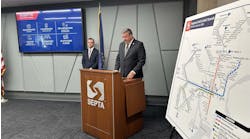Government of Canada to invest C$275.7 million in funding through Canada Public Transit Fund to help cities in Ontario fund transit infrastructure projects
The government of Canada will be investing C$275.7 million (US$193.1 million) in funding through the Canada Public Transit Fund between the years of 2026 and 2036 to help the cities of Brampton and Hamilton, Ontario and the regions of Waterloo and Niagara, Ontario, to help upgrade, replace or modernize their public transit infrastructure and maintain it in a state of good repair. The funding is conditional on the submission of capital plans and the signing of funding agreements.
“We are committed to building high quality and affordable public transit, and this new long-term funding will make a big difference,” said Canada’s Minister of Housing, Infrastructure and Communities Nathaniel-Erskine Smith.
Regional Municipality of Niagara
The Regional Municipality of Niagara will be receiving C$35.7 million (US$25 million) in transit funding.
“With over C$35 million (US$24.5 million) in funding through the new Canada Public Transit Fund, the federal government is securing long-term, predictable support for public transit in Niagara. This investment will alleviate the financial burden on property taxpayers to strengthen local transit infrastructure, making it easier for residents to connect with jobs, services and their communities,” said Parliamentary Secretary to the Minister of Transport and Member of Parliament for Niagara Vance Badawey.
“The Baseline Funding stream of the Canadian Public Transit Fund is an important federal investment that will contribute significantly to the capital priorities identified in our upcoming master plan and fleet electrification strategy. Long-term, stable and predictable funding is vital for the health of transit in Niagara and across Canada as demand continues to grow. We look forward to continuing to work with our federal partners to realize the potential for transit in Niagara,” said St. Catharines Mayor and Niagara Transit Commission Chair Mat Siscoe.
City of Brampton
The city of Brampton will be receiving C$106.2 million (US$74.4 million).
“With over C$106 million (US$74 million) in funding through the new Canada Public Transit Fund, the federal government is securing long-term, predictable support for public transit in Brampton. This investment will alleviate the financial burden on property taxpayers to strengthen local transit infrastructure, making it easier for residents to connect with jobs, services and their communities,” said Member of Parliament for Brampton South Sonia Sidhu.
“This investment in Brampton Transit is a major step forward in expanding and modernizing our transit system. As Ontario’s third-largest city, Brampton needs a strong, sustainable transit infrastructure to support our residents and drive economic growth. The Canada Public Transit Fund will help us build a more reliable, accessible and environmentally responsible transit network,” said Brampton Mayor Patrick Brown.
City of Hamilton
The city of Hamilton will be receiving C$62.1 million (US$43.5 million).
“I am thrilled with today’s announcement and thank our partners in the federal government for this continued investment in our community. This investment will ensure the city of Hamilton’s commitment to providing a public transit system that is inclusive, accessible and sustainable is realized and supports our efforts as we implement a redesigned transit network that will see an expansion – and enhancement of our service. This will make it easier for Hamiltonians to get to places that matter most – getting to work or school, visiting family and friends, going shopping or getting to appointments,” said Hamilton Mayor Andrea Horwath.
“The HSR is pleased to have the certainty that this funding announcement provides. Knowing what funds are available to us for the next decade allows us to plan more effectively, maintain a state of good repair for our fleet and continue to improve transit frequency for our customers,” said Hamilton Director of Transit Maureen Cosyn Heath.
Region of Waterloo
The region of Waterloo will be receiving C$71.7 million (US$50.2 million).
“By investing in transit infrastructure, we’re not just improving mobility – we’re building the foundation for vibrant, sustainable communities where Canadians can live, work and thrive, all while reducing our environmental impact for future generations,” said Member of Parliament for Waterloo Bardish Chagger.
“This long-term investment will help the region of Waterloo maintain and expand the transit system that our community relies on and is proud of. Providing transit service for people that takes them from where they live to where they want to go is the backbone of a transit system that will support Waterloo Region as it continues to grow,” said Waterloo Regional Chair Karen Redman.
Société de transport de Montréal (STM)
For the government of Quebec’s 2025–2026 pre-budget consultations, the STM has submitted prioritized pre-budget recommendations focused on local investment through the maintenance of the Montreal metro infrastructure, vital to economic security.
STM notes the investment deficit for métro asset maintenance has climbed past C$6 billion (US$4.2 billion) in the past few years. According to STM, under the current Quebec infrastructure plan (QIP), the proportion of funds made available for this purpose is at its lowest since 2013. STM says asset maintenance accounts for only 18 percent of the government of Quebec’s total investments in public transit under the QIP, compared to 82 percent for roads and 62 percent for the entire plan.
According to STM, a lack of infrastructure maintenance is the number one challenge facing public transit today, a challenge that puts the STM’s ability to keep delivering reliable, quality public transit at risk, as well as security.
“These figures show that more needs to be done,” said STM Board of Directors Chair Éric Alan Caldwell. “The métro will soon be 60 years old and putting off maintenance work only leads to higher operating and maintenance costs and a subpar customer experience.”
The STM is recommending:
- Additional funding in the 2025–2035 QIP of C$585 million (US$409.7 million) over three years for métro asset maintenance programs.
- An increase in the amounts set aside for asset maintenance in the QIP, gradually moving towards recurring, indexed funding of C$560 million (US$392.1 million) annually.
STM notes the funding would allow the agency to maintain its métro infrastructure, such as tunnels, stations, waterproofing membranes, train garages and maintenance shops, as well as built-in equipment, such as escalators, ventilation systems, electrical equipment and telecommunications systems. STM says the local economy will also be stimulated, as 97 percent of STM's expenditures are made with more than 1,500 Quebec suppliers.
Replacement of 50-year-old trains
STM notes asset maintenance also specifically includes rolling stock and related infrastructure. The STM’s MR-73 trains will be 60 years old in 2036 and are already one-tenth as reliable as their AZUR counterparts. The agency notes it took about 15 years from the start of the project for the AZUR trains to be delivered.
According to STM, the Green and Yellow lines will need to be modernized as well. Given the scale, impact and timeframe of the project, STM says it urgently needs to begin the project studies, especially since acquiring new trains and replacing the train control system on the Green Line could increase its capacity by 37 percent.
The STM is recommending immediate funding of C$40 million (US$28 million) for the studies needed to modernize the Green and Yellow lines, including the replacement of the MR-73 trains
“The Montréal métro is the number one way of moving people around in the Greater Montréal area with nearly 800,000 trips per day,” Caldwell said. “Service interruptions can cause severe economic damage and push more customers into cars over the medium term, which makes traffic congestion even worse and increases its already staggering costs. Clearly, maintaining métro assets is crucial for the city’s economic security and prosperity.”

Brandon Lewis | Associate Editor
Brandon Lewis is a recent graduate of Kent State University with a bachelor’s degree in journalism. Lewis is a former freelance editorial assistant at Vehicle Service Pros in Endeavor Business Media’s Vehicle Repair Group. Lewis brings his knowledge of web managing, copyediting and SEO practices to Mass Transit Magazine as an associate editor. He is also a co-host of the Infrastructure Technology Podcast.


